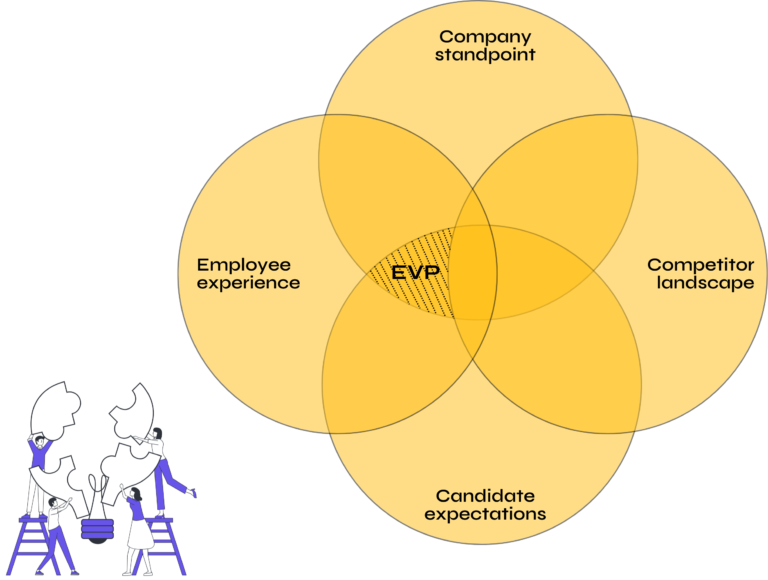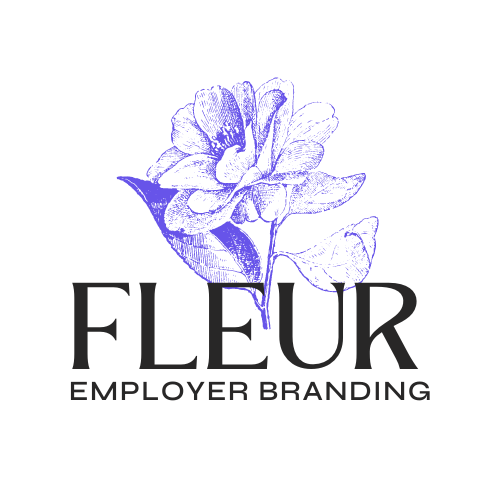the gist of it all
Employer Value Proposition (EVP)
Like the North Star shining bright, the EVP serves as your guiding light in sculpturing your people strategy. It defines your identity as an employer, capturing what you stand for and ensuring it resonates with the aspirations and needs of the talent you seek.
A compelling EVP goes beyond a logical narrative; it resonates emotionally, showcasing the unique aspects of your workplace that captivate and attract top talent.

Why it matters
The EVP is crucial for businesses, from SMEs to global enterprises. It shapes the employer brand by promoting positive employee sentiment and aligning the expectations of both current and future employees with your business goals.
This synergy sets the tone and direction for the entire talent experience, enabling companies to attract, engage, and retain exceptional talent.
- Set clear expectations — drawing in talent that aligns with your mission and values
- Establish a robust foundation for employer branding
- Enhance employee engagement and loyalty
- Decrease turnover and reduce hiring expenses
- Boost job satisfaction and promote employee advocacy
The 4 EVP perspectives

Identifying the Sweet Spot
Authenticity, consistency, differentiation, and clarity are the pillars of a strong EVP, one that is built on mutual value exchange.
Constructing an EVP takes the four following perspectives into consideration:
- Company: aligning the EVP with your strategy and priorities
- Employees: understanding the needs and aspirations of your workforce
- Candidates: meeting the expectations of your talent pools
- Competitors: setting your brand apart from competitors’ strengths
Our structured process
The 4 Ds of crafting the EVP
Align rationales and goals
To integrate the EVP with your strategy and priorities, we first need a deep understanding of your internal landscape.
Questions might include:
- What challenges are you looking to tackle?
- How do you currently engage and keep your employees?
- What are your talent pools? What do they value?
- How do you define success? What are your KPIs?
Research & insights
This critical step involves gathering both internal and external insights.
- Internal employee insights: Analyse existing HR data and employee feedback, conduct surveys, interviews, and focus groups.
- External talent perceptions: Explore market trends, candidate preferences, and external brand perceptions.
- Competitor benchmark: Study competitors’ positioning and conduct SWOT analyses.
Translate insights into narratives
From the insights gathered, we create a compelling narrative supported by evidence and positive highlights. This becomes your EVP framework, whose purpose is two-fold:
- Crafts an overarching statement that outlines the unique benefits and opportunities for both employees and prospects.
- Identifies key attributes and themes to guide employer branding and communication strategies that resonate with various talent segments.
The outcome is a comprehensive EVP playbook with strategic communication guidelines and templates aligned with your corporate branding.
Internalize and incorporate
- Cascade the EVP (messaging, branding, etc.) through internal processes, initiatives, and communication channels.
- Integrate it into external candidate-facing communications.
- Provide training to support the rollout.
- Track key metrics to measure and improve the EVP’s effectiveness.
Making the final arrangements for the EVP rollout and fine-tuning it to ensure that it resonates with the target stakeholders at key touchpoints of the employee lifecycle and recruitment funnel commands special attention. That’s why we have a dedicated section.
THE ADJUSTMENT BUReau
Employer Brand Activation
The EVP exercise ties into the wider paradigm of employer branding, which brings its own considerations in terms of location, budget, and operational nuances.
So when it comes to transforming the EVP into explicit communication assets and adapting campaigns to connect with personas across channels and platforms, the concept of Employer Brand Activation comes into play. This involves refining EVP messaging, configuring career sites, running targeted advertising, and commissioning multimedia content to bring your EVP to life.
FAQs
Employee and Employer Value Proposition are often used interchangeably, but they do focus on different aspects.
- The Employee Value Proposition focuses on the unique set of offerings employees can expect, such as compensation, work-life balance, career growth opportunities, etc. It’s a high-level summary of all the benefits that come with being employed in the company.
- The Employer Value Proposition focuses on how the company strives to be perceived by its employees, candidates, and other potential stakeholders. It also outlines the expectations for the ideal candidate and desired target groups, which the company wants to attract, engage, and retain.
The Employer Value Proposition (EVP) incorporates the more objective elements listed in the Employee Value Proposition and goes further by looking into narratives and other factors that can strengthen the employer brand, all while ensuring a mutually beneficial relationship.
When it comes to measuring the effectiveness of your EVP, it’s important to track key metrics throughout the entire talent lifecycle—from attraction to retention, and beyond (e.g. alumni network).
For instance, metrics that provide clear and direct evidence of the value generated by EVP initiatives, such as the number of candidates who applied, were interviewed, and got hired, are of particular interest – as well as cost savings, speed of hiring, etc.
The discussion around metrics and KPIs should happen right from the start, as outlined in our ‘4 Ds of crafting the EVP’. This, for two reasons; first and foremost, we naturally want the capacity to monitor the achievement of the EVP goals and objectives (remember to record a baseline). Now also, the conversation might help inform some of the actions and points to elucidate when developing the EVP later on.
One of the most common mistakes we’ve seen is taking a one-size-fits-all approach. For example, one that would discount the diverse perspectives of key stakeholders and target talent pools, resulting in potential disconnects down the line and failure to meet some expectations.
Understanding and addressing the unique preferences of different demographics, locales, etc. is central to the process.
- Seasoned professionals seek acknowledgment of their expertise, opportunities for leadership, and a sense of stability
- Early-career hires yearn for mentorship, opportunities for learning and engaging, and thrive in dynamic work environments
- Baby boomers value stability, long-term benefits, a reputable company legacy, etc.
- Gen X pursue career advancement opportunities, work-life balance, and autonomy
- Millennials are after purpose-driven work, career growth, and flexible work arrangements
- Gen Z are drawn to diversity, technology, and innovation
In addition, we noticed many employers overlook the deeper motivational drivers that inspire employees and candidates alike.
The EVP distills the very essence of the employer brand. It highlights both the tangible (salary, bonus, workspace, etc.) and intangible (culture, work-life balance, career progression, etc.) benefits of working for the company.
The employer brand animates the EVP by clearly articulating the reasons to join and stay with the company through authentic storytelling and ongoing communications.
While EVP and employer brand are distinct concepts, their unison brings about a cohesive and attractive employer image, as part of the overall employer branding effort.


